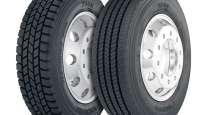Largest Tire Makers Hike Prices as Raw Material Costs Soar
This story appears in the May 10 print edition of Transport Topics.
The nation’s three largest manufacturers of commercial truck tires have raised prices for the second time this year in reaction to sharp increases in the costs of their primary components — rubber, oil and steel — although world economic developments have taken some of the air out of commodity prices.
Bridgestone Bandag Tire Solutions last week said it would raise prices on new radial tires by 6% on June 1, and that it had boosted retread materials prices by 6% on May 1. The company has a 25.5% market share of heavy- and medium-duty truck tire sales, according to Modern Tire Dealer magazine.
On May 4, Goodyear confirmed that, as of May 1, it had raised commercial truck tire prices by as much as 8% on its Goodyear, Dunlop and Kelly brands. The company also raised retread prices by up to 7%; it has a 24% market share.
On May 1, Michelin North America raised its price on aftermarket truck tires and retreading material by 3% to 7%, the company said April 5. Modern Tire Dealer gives Michelin a 22% market share, with all other manufacturers each claiming less than 10% of the market.
“Bridgestone Bandag Tire Solutions continues to look for ways to balance costs and continue to deliver a premium package of value to our dealer and fleet customers,” Kurt Danielson, a Bridgestone vice president, said in his company’s statement.
“However, we have reached a point where we must increase prices due to the unrelenting escalation of costs outside of our control for energy, fuel and raw materials,” Danielson added.
On April 23, rubber on the Tokyo Commodity Exchange topped the equivalent of $4.80 per kilogram, the highest price ever. In the December 2008 price collapse that affected rubber, oil and other commodities, rubber had fallen to as little as $1.03 per kilo, dropping 71% from the previous high of $3.586 in September 2008.
The Rubber Manufacturers Association said U.S. businesses bought 18.67 million heavy- and medium-duty truck tires in 2008, with 79.5% of them purchased in the aftermarket and the rest going for new equipment.
Crude oil, the basis of synthetic rubber, was less than $72 a barrel in February before topping $86 in April and May, an increase of 22%.
Hot-rolled coil steel prices closed out 2009 at $510 a ton on the New York Mercantile Exchange and moved up 37% to $700 at the end of March.
Tire prices were very stable last year when commodity prices remained low, said Peggy Fisher, president of consulting firm TireStamp Inc., Rochester Hills, Mich. This year’s first round of increase came around Feb. 1, and she thinks there may be a third round in the fall.
“The prices of raw materials are up so much, and when we see a 6% increase, it doesn’t all stick right away,” said Fisher, who is active in the Technology & Maintenance Council of American Trucking Associations.
Fisher attributed the prediction of a September price increase to an investors’ report by Deutsche Bank Securities.
While commodity prices always fluctuate, she said China and India will continue to drive demand by buying large amounts of rubber and oil to make tires for themselves and for export. Cheap tires and oil are relics of the past and not likely to return, she said.
“If you think you’ll see $2 [per gallon] diesel or $300 truck tires, it’s not realistic. The average truck tire is now $400,” she said, urging fleet managers to be vigilant on tire maintenance to save on fuel and extend tire life.
Bad world economic news over the past two weeks has provided some relief for commodities buyers. The Greek financial crisis and continued worry over Spain, Portugal and some other European economies caused rubber to drop below $4 a kilo on May 6, at least for a while.
Bloomberg News reported on May 6 that “rubber tumbled on concerns that deepening sovereign debt risk in Europe may slow the region’s economic recovery, curbing demand for raw materials, and as the prospect of increased supply reduced the commodity’s appeal.”
“Increasing [rubber] supply in southern Thailand after the wintering season also pressured market sentiment, dragging prices lower,” Chaiwat Muenmee, an analyst at DS Futures Co., told the wire service in the same report.




